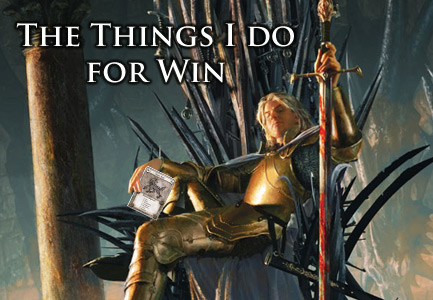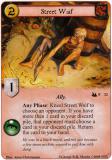Welcome to Card Game DB
Register now to gain access to all of our features. Once registered and logged in, you will be able to create topics, post replies to existing threads, give reputation to your fellow members, get your own private messenger, post status updates, manage your profile and so much more. If you already have an account, login here - otherwise create an account for free today!
Register now to gain access to all of our features. Once registered and logged in, you will be able to create topics, post replies to existing threads, give reputation to your fellow members, get your own private messenger, post status updates, manage your profile and so much more. If you already have an account, login here - otherwise create an account for free today!
The Things I Do For Win - Recursion
Feb 01 2013 06:15 AM |
clu
in Game of Thrones
Small Council The Things I Do For Win clu Recursion has gotten quite the lip service in the last couple of months due to House Targaryen returning to prominence and along with it; the lowly Street Waif. For a cost of two gold you get a card returned to your hand from the discard pile. If nothing else, the ragamuffin replaces itself the turn you play it. It isn’t until you trigger him a second time do you pull ahead in card advantage.
Recursion has gotten quite the lip service in the last couple of months due to House Targaryen returning to prominence and along with it; the lowly Street Waif. For a cost of two gold you get a card returned to your hand from the discard pile. If nothing else, the ragamuffin replaces itself the turn you play it. It isn’t until you trigger him a second time do you pull ahead in card advantage.Creating card advantage exists in many forms. Consider you and your opponent each have five cards in hand and four cards in play, giving each player a total of nine cards. When I play a card from my hand the total number of cards; known and unknown by my opponent; is still nine. If I play all five of my cards the card count is still nine to nine. All of mine just happen to be in play, which gives me more options, but, we are still tied nine cards to nine.
Card Advantage
The last article I wrote focused on drawing cards. Using the same scenario, four in play and five in hand, let’s say I play a Carrion Bird with Samwell in play. My total is now five cards in play and six in hand, giving me a total of 11 cards versus my opponents nine. I have created card advantage by two.
Another example is playing Newly Made Lord. Using the same set up, four down and five mitted; I play the Greyjoy beater and discard an opponent’s location. I still have nine cards with five in play and four in hand while my playmate is now down to three in play and five in hand for a total of eight. It may not seem like a lot but I have edged out a single card of advantage. A couple more plays like that and I will have widened the gap giving me more options than my opponent.
Events a bad proposition for the most part garnering card advantage. When you play an event and the effect doesn’t draw multiple cards, remove, or lead to a card being removed from the board you are giving up card advantage. Condemned by the Council is great example of a best case scenario. I play it; I remove a card from their side of the table. I don’t gain card advantage but, I do keep the status quo. Look at the events in top tier decks, I will take bets that each one grinds towards tipping the balance in your favor.
Challenges are the easiest way to widen the gap. Winning a claim two military or intrigue challenge are the easiest ways to gain the advantage. Even winning a claim one and defending one of those is a push for the positive. I will often let early challenges go through so I can make sure mine succeed because I’m usually packing more card advantage effects.
This leads into my mantra, the more options you have the more win you have. Drawing cards and one sided character effects are straight forward paths towards card advantage. Recursion is a vastly dragon of a different color.
The Zero Effect
Consider each recursion piece on its own merits. For the most part a card that recurses doesn’t do anything for card advantage. Playing a deck full of recursion effects is basically spinning its wheels. Play a card; get a card for no net gain. You are better off just playing something that lets you draw or better yet, just play a card that is a threat on the board. Recursion isn’t always the answer.
Assuming the deck is 60 cards and three of those cards are recursion based. Those three cards are bumping out other efficient cards that don’t require other target cards to reach their potential. During setup and turn one your deck has been reduced to 57 playable cards, restricting your options. You are losing out on opportunity cost. By choosing a recursion card, you are NOT choosing a character that can win you challenges. And, if you play the recursion card to put a two cost vanilla pud into play you have wasted a slot in your deck. Recursion is a supplemental tool, a top tier deck it does not make.
The Street Waif: An Example of Mediocrity
Take the vaunted Street Waif, a two cost for one strength moncon. Using the four cards in play and five in hand parameters, playing a Street Waif keeps the numbers even with you having five on board and four in hand. Kneeling the Waif puts one card in your hand, giving you five in play and a fist of five. Because you have to kneel the Street Waif he is no longer a threat on the board, reducing the cards you have in play to attack or defend to four. He has only replaced himself. There is no net gain during challenges.
During the standing phase you can trigger the Waif again, giving you another card in hand. Imagine that neither a military or intrigue challenge was won by your opponent (that’s a pipe dream). You now have four cards in play (not counting the Waif because he’s knelt again) and six in hand for a total of ten. That is a single card gain. Given a long enough time line that little guy will kill an opponent due to card advantage.
Good thing he’s balanced, touting only one strength. If nothing else that little man can walk across the board for an intrigue challenge. And, the seven forbid, you pair him with Long Lances. The more triggers you get beyond the first one is pure gas. Sustainable recursion is akin to free cards and can double up your advantage versus an opponent’s draw assuming you are playing with card that do stuff (next article!).
Creating Card Advantage with Recursion
Digging yourself out of the card advantage hole requires one of three things. The target that you bring back into play removes another card from the board, is far beyond your gold curve and can dominate challenges, or you pull back more than one card. Note: if a single recursion effect doesn’t put a character into play it probably not worth playing. It’s no good to pull back that king or queen during dominance if you still can’t afford to play it.
White Cloak Arsenal - Recursion Options
I have been focusing on the beginning of the game. Recursive effects are at their best during turn three and beyond. You should have some cards in your dead and discard pile to choose from. The value of a recursion card is only as good as its targets.
Looking at the example of a 60 card deck with three recursion cards; those three cards can represent a four cost dragon, seven cost army, or even a challenge stopping event. Those three cards now give you more options for a tool-box approach to the game. The bigger your target area, whether it is the discard or dead pile, the more options you possess. You can bolster that by purposely dumping cards.
Here is an important statement, recursion isn’t better than card draw. But, it can garner mismatches by broadening your options. A mix of both is ideal. An Orphan is pretty good on its own, but, versus an opponent who has a single giant dude they become invaluable.
Final Thoughts
I love recursion. There is only one other mechanic that I love more and it’s more of a belief of theory, kill everything (Dear Westeros Bleeds, I heart you). My first tournament I won was with a recursion deck way back in the day. I could get Red Viper and an 8 str Stark army on board turn one with regularity out of House Lannister. If the opponent could withstand the initial onslaught I packed the deck with tool box characters from all six houses. The day for a pure recursion deck is getting closer but is still shy of winning it all. I hope this encourages folks to explore returning cards as a supplemental addition.



 Sign In
Sign In Create Account
Create Account












6 Comments
Recursion is not limited to 3 times per turn, you can draw in addition to your recursion and draw gets you a random card, recursion usually gives you cards that you choose.
Recursion isn't better than draw?
Think about that last sentence. You're playing with a 57 Card deck. That Recruitment (VD) or Ambush from the Plains (QoD) isn't an event, it's another copy of Long Lances (THoBaW) or Company of the Cat (THoBaW), or why the hell not, even another Street Waif (AToT).
I had an opponent last night who, everytime I triggered Street Waif, gave me back Much And More (AHM). It never occurred to him that he was giving me opportunities to burrow through my deck for choice cards, while I gave him 2 dead uniques, a late-game Fiefdoms, and a key event that was promptly subjected to Confession (KotS). Card advantage like a boss.
Card advantage is having playable options. With recursion, next to your deck are a couple of "save that for later" piles. On a slightly different subject, the times I've played my jerry-rigged Black Sails deck felt a little like playing a recursion deck, where my card advantage is enhanced by having the opportunity to pluck out the card I want most.
Think about that last sentence. You're playing with a 57 Card deck. That Recruitment (VD) or Ambush from the Plains (QoD) isn't an event, it's another copy of Long Lances (THoBaW) or Company of the Cat (THoBaW), or why the hell not, even another Street Waif (AToT).
On set up, no its not a copy of Long Lances (THoBaW) in fact those recursion events aren't quite good early game with no options in either the dead/discard pile.....which was exactly what clu was saying "Recursive effects are at their best during turn three and beyond."
Well, if you use Knights of the Hollow Hill (MotM) as your agenda you don't have to worry about those pesky set ups.
There are even two sides of reasoning with KotHH too. On one hand missing out on setup cards doesn't mean a thing, on the the other hand, you are now further away from putting cards into the dead/discard pile. Recursion doesn't work if there isn't anything to return.